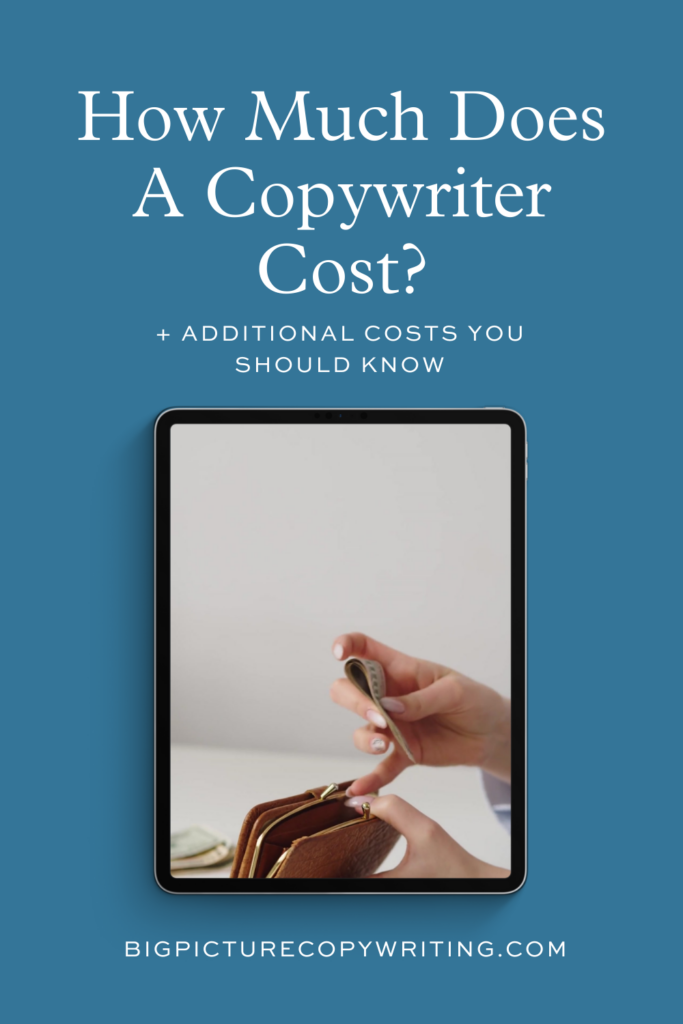Hiring a professional website copywriter can relieve you of the stress and anxiety (not to mention the hours) spent trying to DIY your copy. However, working with a freelance copywriter can also seem daunting if you’re not familiar with the process. From the initial discovery call to the final design implementation, each step is crucial for creating your business’ website.
This guide breaks down the entire process, step-by-step, ensuring you know what to expect, how to get the most out of your collaboration with a website copywriter, and how to hand off your copy to a brand or website designer to build your site.
👋 Book a Big Picture Discovery Call
Every project requires some level of customization and the process varies from copywriter to copywriter.
Grab a free 30-minute call with me to discuss your website copy needs and learn how I can tailor the process outlined in this post to fit your project’s needs.
Step 1: Book A Discovery Call
A discovery call is as much for your benefit as the copywriter’s. A discovery call allows you to feel out the copywriter, determine whether you’re a good fit, and for the copywriter to get a better idea of what you need.
You’ll discuss your business, industry landscape, audience, offers, and goals, and get the chance to ask questions or gain clarity about the copywriter’s process.
The copywriter will likely suggest which pages you need or will want to start with if you can’t do it all at once). They will also inquire about your budget, website platform, and whether you’ll be working with a website designer after the copy is delivered or if you’d like the copywriter to refer you to their preferred design partners.
Key Questions to Ask A Copywriter
1. Can you show examples of your previous work?
2. What is your process like?
3. How much time will be required to review and provide feedback?
4. How collaboratively do you work with your clients?
5. How do you incorporate SEO into your writing?
6. Do you work with a website designer after the copy handoff?
7. What are your rates and payment terms?
8. Do I have to do everything all at once or can I break the project into phases?
Step 2: Review the Proposal
After the discovery call, the copywriter will draft a proposal outlining the scope of work, timeline, costs, and any other relevant details. Take your time reviewing the proposal and make sure you understand what work will be done, how it will be delivered, and if anything is required of you throughout the process. If anything is unclear, don’t hesitate to ask for clarification.
Elements of a Good Proposal
A comprehensive proposal should include:
- A clear outline of the services to be provided
- Process/how it works breakdown
- Timeline for each phase of the project
- How feedback is conducted (via Zoom, Loom, Slack, asynchronous, etc.)
- How many revisions are included in the scope of work
- Pre-work or questionnaires required to be completed by the client (you) before the project begins
- Estimated cost vs. flat-rate cost
- Payment plan details and payment dates
- Proposed start date and delivery date
- Any retainer fees or maintenance costs
- Contract with terms and conditions
Step 3: Onboarding
Once the proposal is approved, the contract is signed and deposit payments have been made, you can expect to receive onboarding materials from your copywriter. Onboarding may include:
- A shared client folder
- Pre-work or questionnaires that require completion by the client (you) before the project begins.
- A folder to drop any existing documents, research, or testimonials that will be important for the copywriter to reference and use.
- An audience feedback survey (for you to send to your audience for research and voice-of-customer purposes.)
- Client/customer interviewee contact details (I perform complimentary interviews for all Brand Messaging + Website Copywriting clients.)
Additional onboarding steps include scheduling your kickoff call and check-in meetings if the copywriter prefers to set these dates ahead of time.
Step 4: Kickoff Call
Once all pre-work has been submitted and it’s time to begin, you’ll attend a kickoff call. The format of a kickoff call varies depending on your copywriter’s preference, but I prefer to work through any sticking points I uncovered during my prep work routine and we’ll go through my signature Audience Persona exercise. Here at Big Picture, your kickoff session is not a 3-hour meeting starting with a blank slate.
Here are all the things I do as your copywriter before our kickoff call:
- Research your industry and competitors
- Interview your clients/customers
- Review your Brand Strategy MEGA Questionnaire
- Assess and audit your offers and products
- Look for gaps in the market and ways you can stand out
- Compile notes and questions to dive into during our kickoff call
- Watch videos/podcasts/discovery call recordings to capture your voice and unique speech characteristics
- Prep your audience persona deck (more on this below)
Why I start your project *before* your kickoff meeting:
The cost of my prep time is baked into the cost of the project. It’s much more efficient and way more effective if we both do our homework ahead of the kickoff so we both start on the same page (figuratively speaking.)
If I’ve learned anything in my 15+ years of working with founders, startups, and growing businesses, both as an independent business owner and at any agency, it’s that both parties need to sit down and think critically about your business and project separately, first.
My clients are repeatedly amazed by the clarity and relief they feel after working through my Brand Strategy MEGA Questionnaire. By the time we come together, we’re on the same page, ready to roll, and not in danger of “groupthink” which causes teams to say what they think they should say, instead of the truth.
Step 5: Brand Strategy and Messaging Development
Before any writing begins, it’s essential to establish a strong brand strategy and messaging framework. After the kickoff call, I get straight to work drafting your Brand Messaging Blueprint.
The Brand Messaging Blueprint can include:
COPYWRITING FOUNDATIONS
- Elevator Pitch / Boilerplate
- 5Ps Brand Framework
- Purpose
- Perception
- Personality
- Positioning
- Promotion
- Differentiation Strategy
- Brand Archetype Overview
- Custom Brand Strategy Deck
MESSAGING STRATEGY
- Audience Personas
- Problems Profile
- Solutions Profile
- Brand Story
- Voice & Tone Guidelines
- Messaging Swipe File
- Brand Word Bank
- SEO Keywords & Research
This blueprint is the foundation for copywriting. It tells your copywriter what to write, in what style, and how to address your audience’s internal dialogue, problems, and objections. Everything inside the Brand Messaging Blueprint gets translated into the web copy that appears on your site.
Building out your messaging strategy is a copywriting non-negotiable. Even if you’ve worked through your brand strategy with a coach or designer before, a copywriter’s strategy is keenly focused on your verbal strategy. Do not ask them to skip this part of the process, please.
Step 6: Feedback Loops and Revisions (for Messaging Deliverables)
Collaboration is key to producing high-quality copy. After I’ve completed your Brand Strategy Blueprint I record a Loom video walking you through your deck, making note of any areas I’d like specific feedback or help with.
Feedback is a crucial part of the process, so don’t be afraid to share your thoughts and concerns. Copywriters are professionals and we’ll work with you to make the necessary revisions.
Because I only work with one client at a time, I’m available to discuss feedback and revisions with my clients over Zoom at any time during normal business hours. I generally ask for feedback within 24-48 hours to keep the project’s momentum going and so we can stick to our timeline.
While it rarely takes more than 1-2 rounds of feedback for all revisions to be addressed, I make it clear that our goal is to feel 99% happy and confident with the messaging by the end of the week so I can dive straight into writing copy the following week.
Step 7: Copywriting
Practiced copywriters never start with a blank page. Depending on whether you’re a service provider, product company, or startup, I’ll grab my in-house baseline template and start to “wireframe” the copy sections. I’ll also add SEO keywords and phrases to the top of the doc so that as I’m writing I remember to include them. (See “Editing” below for how I perform a more in-depth SEO sweep after the first draft.)
Website Copywriting deliverables can include:
WEBSITE COPYWRITING
- SEO Keyword Audit & Research
- SEO Page Titles & Meta Descriptions
- SEO-Rich Website Copywriting and Editing
- User Testing Sessions with Interviewees
- (2) Rounds Copywriting Feedback & Edits
How long it takes for your copywriter to turn around copywritten drafts for review is highly dependent on the writer. Typical turnaround time can vary between 1-4 weeks, depending on the scope of work and timeline proposed at the beginning of the project.
Check out my 2-week Brand Messaging + Website Copywriting service here →
What is SEO Metadata and why your copywriter should write this for you
Metadata plays a crucial role in how your website is indexed and ranked by search engines. Meta titles and descriptions help search engines understand the content of your pages and influence click-through rates when your site or pages appear in search results. Your copywriter (not your designer or developer) should write concise, compelling meta titles and descriptions that include your primary keywords and ensure they accurately reflect the content on the page.
Step 8: Feedback Loops and Revisions (for Copywriting)
This is the same Loom-and-Zoom process we used to perfect your brand messaging strategy.
Step 9: Editing and Brand Messaging Blueprint updates
Copywriting and copyediting are two different roles and skill sets: Copyediting checks the nitty-gritty details like correcting grammar, spelling, punctuation, and syntax, and ensuring consistency in style and formatting.
I also “sweep” all copy written for:
- Clarity
- Voice & Tone
- Hook/Big/Idea/So, what?
- Proof
- Specificity
- Emotion
- Risk
- The 4 Buyer Types
- SEO.
Step 10: Delivery Day & Implementation
Typically you will pay the final invoice before your copy docs and messaging deck are “released” and the legal copyright (with an “r”) transfers to you.
Your copywriter will also discuss how they can assist with design implementation (or you should inquire about it if they do not.) Your copywriter might require an implementation fee to touch base with your designer and be “on-call” to address any copy-by-design questions that come up as the designer and/or developer is building your site.
Some copywriters will do this for free, as a sign of goodwill, but it should never be assumed that this additional labor is free, so be sure to ask.
Work closely with your designer to ensure the copy and design complement each other. The design should enhance the readability and engagement of the content. Before the site goes live, conduct a thorough review to ensure everything is in place. Check for any last-minute typos, formatting issues, or broken links.
Future Edits and Changes
A website is never truly finished. You’ll need to continually update your copy to reflect new offers, changes within your industry, pivots in your business, and the evolving needs of your audience.
Plan and budget for ongoing, yearly updates to keep your copy fresh and relevant.
Key metrics to track whether your copy is working for you or not include:
- Lead quality (are the right people inquiring about your services?)
- Return rate (are customers expecting something different than what they are getting? Note: This could be an issue with the product’s quality, rather than the description copy.)
- Bounce rate (are people not finding what they’re looking for and immediately leaving the page?)
- Short heat map (are people leaving the page before they’ve scrolled past at least the top 50% of the page?)
Marketing Your Website
Your copy can’t do its job unless you invest in marketing activities that funnel people to your site. You need to invest in aligned marketing strategies that pull people through your 4-stage marketing funnel: Awareness, Consideration, Conversion, Loyalty
If you’re successfully driving a significant number of visitors to your website through your marketing activities, and you’re not getting the results you want, after 6-12 months of hiring a copywriter it’s worth reaching out and discussing your concerns with them. Together you’ll be able to review your site, audience feedback, and analytics to pinpoint if the problem lies in your ability to Attract, Inform, Convert, or Engage your audience.
Further reading: Do you have a copy problem or a marketing problem?
Priming Your Website Copywriting Process For Success
Working with a website copywriter is a collaborative process that involves careful planning, thorough research, and ongoing refinement. By following these steps, and understanding what to expect, the website copywriting process can feel easy and simple.
✏️When you’re ready to hire a freelance copywriter…
BRAND MESSAGING – A 4-day brand strategy intensive to help you dial in your brand and your messaging.
WEBSITE COPYWRITING – Let me articulate your brand story, co-create your brand messaging, and translate it into powerful web copy that converts.
SALES PAGE COPY – Long-form sales page copy that moves people to buy your courses and offers without giving them (and you) the ick.
COPY TUNE-UP + EDITING – Perfect for the DIYer on a budget. Button up your copy with a professional diagnosis and copy edits before hitting publish.
PIN TO SAVE FOR LATER



